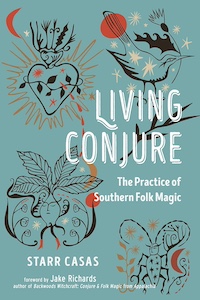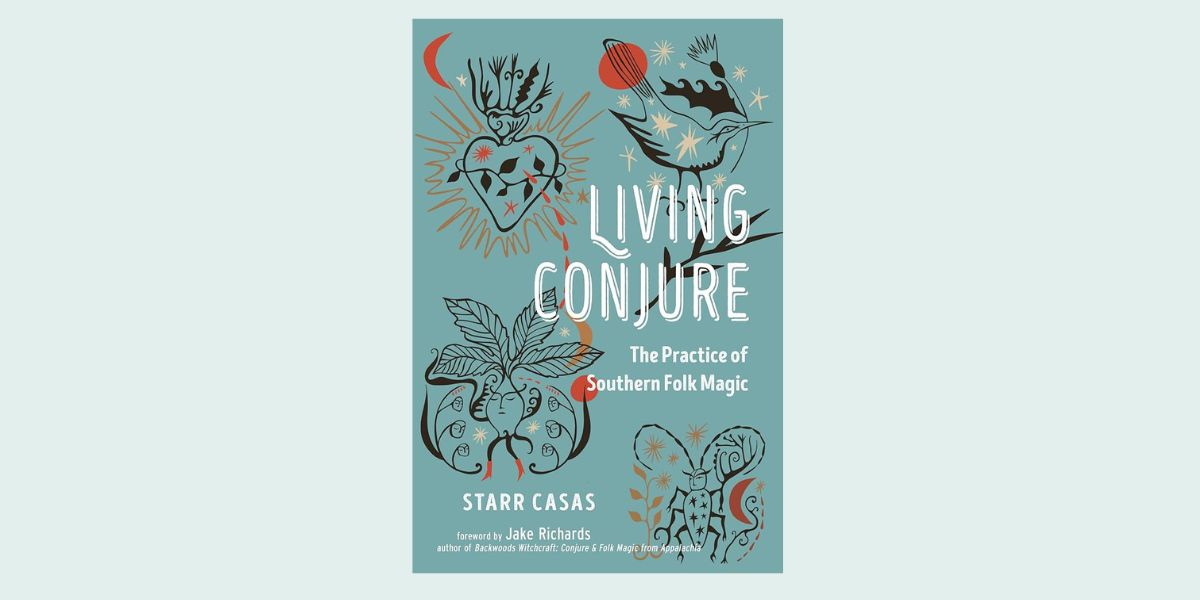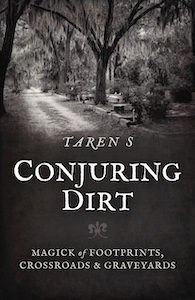
Living Conjure: The Practice of Southern Folk Magic, by Starr Casas
Weiser Books, 1578638240, 208 pages, August 2024
Living Conjure: The Practice of Southern Folk Magic by Mama Starr Casas, a Conjure woman with over forty years of experience, is a comprehensive guide to traditional Southern Conjure that’s accessible to all skill levels, from beginner to seasoned practitioner. A native Kentuckian, Mama Starr’s voice is like a warm hearth fire crackling with wisdom and laced with the sweet smoke of magic. Her writing style emulates the way she was taught: through word of mouth, from her elders. This enchanting prose, delivered with the down-to-earth charm of a beloved granny, immerses readers in a legacy of time-honored Southern secrets. It’s clear that Mama Starr poured her heart and soul into preserving and sharing this invaluable knowledge.
“Don’t forget your roots,”1 Appalachian Conjure man Jake Richards says in the foreword, and those words lingered with me like the whisper of a ghost. I’ve tried running from the South, where I was born, and I’ve rejected the Christian faith in which I was raised. When I lived in New York, some people projected negative Southern stereotypes onto me and wrongly assumed that I voted in a certain way, so I came to realize that I couldn’t run from the South. Wherever I go, she follows me, a phantom belle perfumed with magnolias, and when fate forced me to come back, she reclaimed me. Trying to escape my roots just buried them deep in my shadow. Studying Conjure and incorporating some elements of Southern folk magic into my personal practice has been a therapeutic way for me to reconcile with my roots by digging them up and putting them to good use.
Mama Starr honors the tradition of her elders by teaching Conjure through the lens of children’s folktales, like “Brer Rabbit and the Tar Baby,”2 and the rhythms of old spirituals. These weathered yarns weave a rich tapestry of magic. “The ancestors of this work learned to hide the work in plain sight—that is why this work is called tricks,”3 she explains. This emphasis on subtlety and clever disguise is a core principle of Conjure.
“Conjure, Hoodoo, and Rootwork are all the same thing,” Mama Starr explains. “When I was growing up, I never heard Hoodoo being used as the name for this work. Hoodoo was a question: “Hoodoo you?” Meaning, “Who put roots on you?”4
These terms have evolved over time and their usage can vary depending on the region and the practitioner. However, they all refer to the same tradition of folk magic that has been passed down through generations in the Southern United States.
“Sometimes folks get upset with me because I share so much,” Mama Starr says. “I share it because if I don’t, when I’m gone what’s in my head is going to be gone.”5 She hopes to keep the work alive and honor the memory of the ancestors through her writing.
One chapter explores the use of “The Arms of the Cross”6 in Conjure, associating each arm with a cardinal direction and element. Mama Starr counsels caution when doing this type of work, because one could accidently nail themselves down with a crossed condition if performed incorrectly. In the sample workings she provides, a candle or a petition is placed on one of the cross arms.
“I’m what folks call a two-headed worker, which means that I will do what folks call ‘light’ or ‘dark’ work just as long as the work is justified,”7 Mama Starr says. She emphasizes the importance of performing divination before a working to ensure it is warranted and to take responsibility for your actions.
Most of the workings are very simple and require few tools. Mama Starr teaches how to work Conjure with objects most people already have lying around the house, such as scissors, keys, bottles, and jars. The use of blue bottles in Conjure held the most fascination for me because I’ve always loved decorating with cobalt blue glass bottles and I used to keep them in my kitchen window. It turns out they can be magically charged to keep ghosts away.
“Haunts can’t cross over water,” Mama Starr says, “and it is believed they don’t know the difference between the blue in the paint or bottles and the blue of the water, so they stay away from the homes that have the ceiling of the porch painted blue or have blue bottles hanging in the trees.”8
Before reading this book, I had no idea that blue bottles were used in Southern folk magic to ward off spirits, so I must have had an intuitive instinct to decorate my window with them.
Mama Starr teaches how to honor one’s personal ancestors by tending graves, creating an ancestor altar, and making offerings. However, ancestors need not be limited to blood kin. She also emphasizes the importance of honoring the ancestors of Conjure, “the folks who were brought over here during the time of slavery.”9 “Conjure was born out of slavery, from folks trying to survive during a time when white folks felt they had the right to own another person like they were cattle,”10 Mama Starr says. She admires their courage, wisdom, and cunning intelligence in the face of oppression and hardship.
The shadow of slavery looms large over the South, and it was one of the reasons why I tried to escape my Southern roots. Instead of being ashamed of being a white Southerner and trying to push the horrors of slavery out of my mind, Living Conjure has shifted my perspective to thinking about how I can honor the ancestors of Conjure in my personal practice. Mama Starr writes about them and keeps them in her prayers.
Mama Starr talks about the magical properties of animal curios, such as bird feet and alligator paws, and explains that the use of animal parts in magic can be discerned by observing the animal’s natural behavior. I have a flock of egg-laying hens, so her insights into using eggs and chicken feet in Conjure were especially significant for me. She points out that chickens are resourceful and scratch around in the dirt all day looking for food, so their claws can symbolically rake in money. Their feet are also protective because their claws are sharp enough to draw blood. She gives detailed instructions for multiple workings with the feet, as well as how to perform an egg cleansing.
The chapter on “Dirts and Powders” was also very insightful. Mama Starr points out that the virtues of various dirts can be like a double-edged sword. For example, bank dirt can bring prosperity, but one should keep in mind that banks also repossess property, and so the energy of loss and poverty may be mingling in that dirt. I recently started working with bank dirt this year, and this passage enriched my understanding of how to use it.
Mama Starr’s website claims that “she has tried to keep the work as pure as possible,”11 and for her, that means you can’t take the Bible out of Conjure. If you do, it’s not Conjure. However, in this book, she adopts a more lenient approach, teaching the role the Bible plays in Conjure and leaving it up to readers to decide whether or not they want to use it.
I’ve had a complicated relationship with the Bible. Being raised in a conservative Christian household, I had a little pink Bible that I used to read in bed as a child. When my mother disciplined me, one of her favorite punishments was for me to hand copy Proverbs three times each. As an adolescent, I lost faith, read more critically, and became jaded with the misogyny I found in the scriptures. I’m against burning books, so I’ve done my best to make peace with the Bible. College taught me to read it as a work of literature, and Living Conjure is helping me reconnect with it as a powerful grimoire, rather than a source of judgment and condemnation.
“Since the ancestors were forced to become Christian, they put the Bible to good use,”12 Mama Starr says. This passage spoke to my soul because my mother put the fear of God into me when I was a small child, and like it or not, that indoctrination is a major theme in the first chapter of my origin story, and a part of who I am. If you try to take the Bible out of Conjure, Mama Starr says it’s like throwing the baby out with the bathwater, and “you are weakening the foundation that the ancestors built through their blood, sweat, and tears.”13
Mama Starr emphasizes that Conjure is a magical practice, not a religion. The Bible is a religious text, but it is also a spellbook. It can be used for divination in a practice called bibliomancy, and Mama Starr teaches how to receive messages from Spirit using this method. While many Christians believe that divination is a sin, Mama Starr cites biblical passages to the contrary, which describe divinatory practices and claim that the gift of prophecy comes from God. “Men of the churches have tried to remove God’s gift out of the churches, but you can’t take away what God has given,”14 Mama Starr says.
About five years ago, I had a dream that I was in an underground chapel with my mom, and a big black goat of the Witches’ Sabbath was standing on its hind legs in front of her, holding the Bible open like a living lectern. She was so spellbound by the Word that she didn’t even realize the Devil was the one holding the book. I woke up from that dream thinking of the Bible as the Devil’s Black Book, and from then on I recognized it as a powerful tool for witchcraft. Living Conjure has given me deeper insight into putting it to good use.
I may not like some of my roots, but I’ve chosen to own them. After all, if you want to find your power, it’s in your shadow. It’s in those potent roots you keep buried deep, the ones that don’t ever want to see the light of day. If Southern folk magic is part of your heritage, then Living Conjure is a valuable guide that can help you reclaim your roots and tap into that subterranean current of power.

Rachel Christina McConnell is a witch, tarot reader, intuitive astrologer, and writing spider. She holds an MFA in Fiction from Columbia University in the City of New York. Her short stories have appeared in Dark Moon Lilith Press and Minerva Rising Press’s The Keeping Room. Links to her publications are available here: https://rachelchristinamcconnell.wordpress.com


